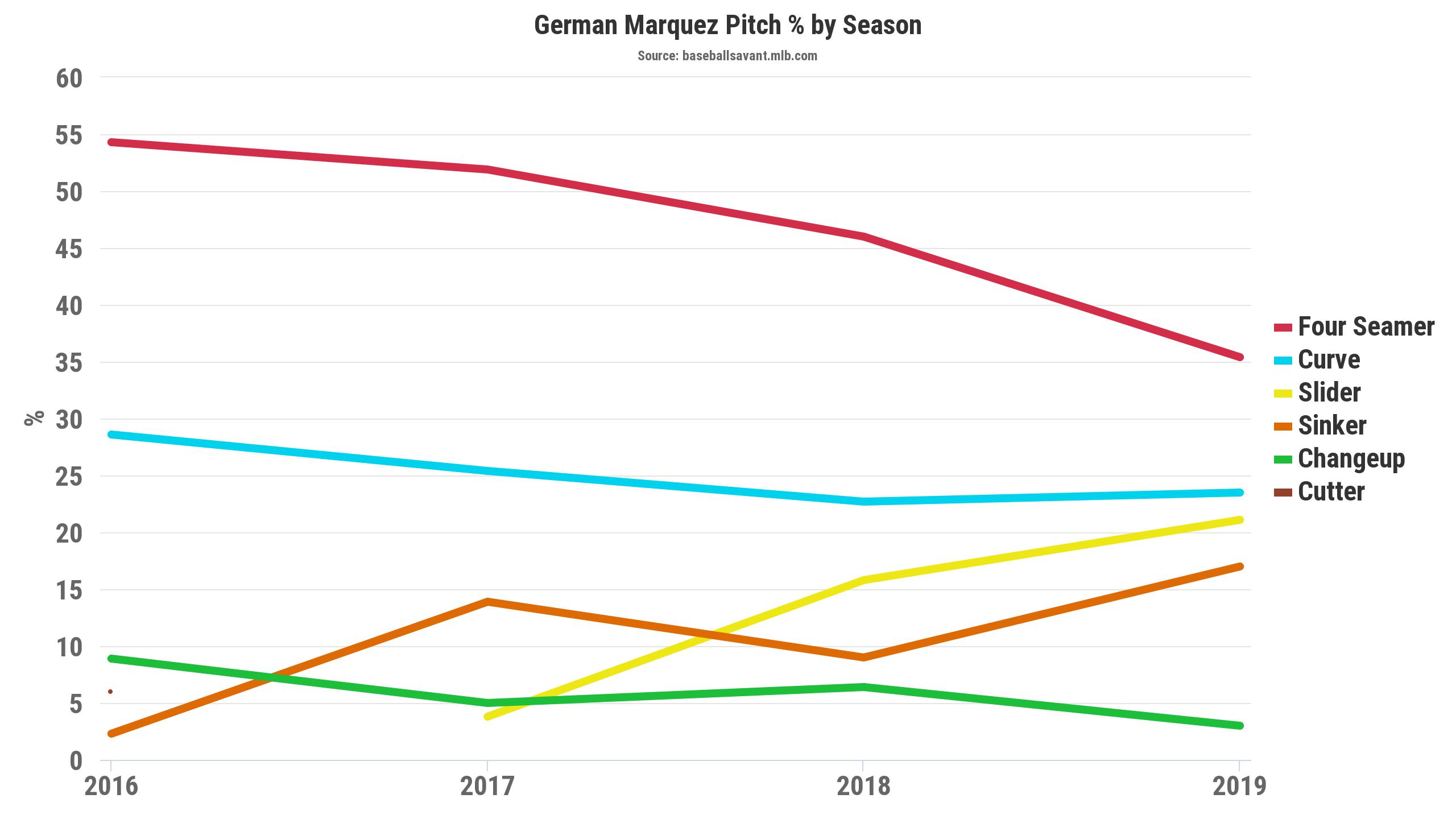Coming into 2019, German Marquez was a breakout favorite coming off of his astonishing 2018 campaign. It seemed as though Marquez had cracked the code on being an ace-like Rockies pitcher, and even though this tempered expectations, the excitement was still there. Unfortunately, Marquez followed it up in 2019 with a lackluster campaign that brought expected and significant troubles in the Rockies’ home, Coors Field.
| Season | IP | W | L | ERA | K/9 | BB/9 | FIP |
|---|---|---|---|---|---|---|---|
| 2018 | 196 | 14 | 11 | 3.77 | 10.56 | 2.62 | 3.40 |
| 2019 | 174 | 12 | 5 | 4.76 | 9.05 | 1.81 | 4.06 |
Because of this, many have simplified Marquez down to “he’s great away and bad at home.” However, this is way too oversimplistic for Marquez, especially considering his skillset fits Coors Field perfectly. Not to mention, his numbers at Coors are actually not as bad as you would think.
Strikeouts Aplenty
One of the keys to Marquez’s success in 2018 was his dominant swing-and-miss ability. He finished seventh in strikeouts that year with 230 in 196 innings. It makes sense that this would lead to success in Coors; if you prevent hitters from putting balls in play, those cannot be exacerbated by Coors and come back to bite you. Unfortunately, the strikeouts didn’t really carry over from 2019. Marquez’s K/9 dropped from 10.56 in 2018 to 9.05 in 2019. This is despite the fact that his elite swinging strike rate actually increased in 2019. This is the first of many examples we’ll see of the underlying numbers for Marquez getting better in 2019 even though his results are getting worse.
| Season | K/9 | SwStr % |
|---|---|---|
| 2018 | 10.56 | 12.5 |
| 2019 | 9.05 | 12.7 |
What Went Wrong?
Marquez is a master at generating “whiffs” on his offspeed stuff. If we look at his pitch selection and corresponding results, he primarily throws his four-seamer, curve, and slider. Even though the four-seamer leaves quite a bit to be desired, the curve and slider are two pretty great pitches considering Marquez’s home ballpark. Unfortunately, Marquez deployed his sinker more in 2019, which is part of the reason for his struggles. To put it simply, his sinker is not a great pitch, and it gets absolutely mashed. The slugging percentage for it was in the .540s in both 2018 and 2019, and this includes his away starts as well!
| Season | Pitch Type | % | BA | xBA | SLG | xSLG | Exit Velocity | Whiff% | PutAway% |
|---|---|---|---|---|---|---|---|---|---|
| 2019 | Four Seamer | 35.4 | 0.296 | 0.313 | 0.488 | 0.517 | 90.5 | 15.3 | 16.9 |
| 2019 | Curve | 23.5 | 0.130 | 0.157 | 0.213 | 0.251 | 87.3 | 43.8 | 29.7 |
| 2019 | Slider | 21.1 | 0.295 | 0.263 | 0.583 | 0.520 | 88.8 | 38.7 | 25.4 |
| 2019 | Sinker | 17.0 | 0.364 | 0.368 | 0.545 | 0.602 | 93.1 | 9.0 | 7.1 |
| 2019 | Changeup | 3.0 | 0.500 | 0.512 | 1.250 | 0.855 | 91.9 | 8.3 | 0.0 |
| 2018 | Four Seamer | 46.0 | 0.312 | 0.285 | 0.500 | 0.445 | 90.3 | 18.5 | 15.9 |
| 2018 | Curve | 22.7 | 0.148 | 0.140 | 0.270 | 0.238 | 86.7 | 47.4 | 33.1 |
| 2018 | Slider | 15.8 | 0.152 | 0.181 | 0.248 | 0.261 | 85.2 | 42.4 | 27.7 |
| 2018 | Sinker | 9.0 | 0.344 | 0.264 | 0.525 | 0.399 | 90.1 | 13.0 | 4.2 |
| 2018 | Changeup | 6.4 | 0.270 | 0.236 | 0.541 | 0.471 | 90.0 | 19.4 | 16.7 |

A more intriguing pitch arsenal change for Marquez in 2019 was that he used his slider a little more. As was already mentioned, the slider is a pretty great pitch all things considered. The downside of this is that Marquez lost a lot of his vertical and horizontal break from 2018 to 2019. The slider was flattening out, and as a result, it went from a .152/.181 BA/xBA pitch to a .295/.263 BA/xBA pitch. While this may be a stretch, his struggles with the slider might not be skill-based but due to the actual baseball. Masahiro Tanaka and Justin Verlander commented on how the laces on the baseball in 2019 were placed differently than in the past which could cause serious grip and spin-rate issues. It’s hard to say whether this is the case for Marquez or not, but the other possible reason is the pitch moving differently in the high altitude of Coors Field. I am less inclined to agree with this only because Marquez’s slider breakout in 2018 also included Coors stats, and I don’t see how he suddenly no longer had it figured out and calibrated without an additional variable being added in.
| Season | Vertical Break (in.) | Horizontal Break (in.) |
|---|---|---|
| 2018 | 37.2 | 2 |
| 2019 | 33.5 | 0.4 |
We’ve Made Contact
The batted ball outcomes for Marquez are what could make him a tailor-made pitcher for Coors. Let’s start with the bad. Marquez’s hard contact rate is pretty bad. There really isn’t any way around that. In Coors Field especially, that just isn’t going to work. Although, the results aren’t nearly as bad for his slider or curve. The sinker is, of course, the worst culprit contributing to this issue, but again, the fastball isn’t completely innocent either. If Marquez wants to find consistent success, he has to get his fastball close to the dominance of his breaking stuff.
Yet, here’s where we have our next example of the underlying numbers complicating our perception of Marquez, whether that be the underlying numbers getting better despite the results in 2019 or a home vs. away anomaly. According to Fangraphs, his hard contact rate barely increased from 2018 to 2019, but his HR/FB ratio pretty steeply increased. This is similar to the K/9 dropping even though his swinging strike rate increased.
| Season | Hard% | HR/FB% |
|---|---|---|
| 2018 | 37.3 | 15.7 |
| 2019 | 37.9 | 20.1 |
On top of this, Marquez actually allows substantially more hard contact on the road than at home. Even though Marquez does have an issue with giving up hard contact, the good news is that he does it significantly more on the road than in the hitter haven that is Coors Field.
| Season | Hard% Home | Hard% Away |
|---|---|---|
| 2018 | 35.1 | 39.3 |
| 2019 | 34.8 | 40.5 |
Better yet, Marquez’s ground ball rate increased, his fly ball rate decreased, and his line drive rate decreased from 2018 to 2019. These are all great things, but this will be expanded upon more in just a second.
| Season | GB% | FB% | LD% |
|---|---|---|---|
| 2018 | 47.3 | 29.8 | 23.0 |
| 2019 | 49.0 | 29.0 | 22.0 |
The Coors Field Sized Elephant in the Room
That brings us to the commonly touted strategy with Marquez, “Great on the road and bad at home”. That’s not necessarily wrong on the surface. Marquez had a 6.26 ERA at home in 2019, yet his road ERA was a strikingly good 3.67. This was duplicated, but in a less significant way, in 2018. Despite those surface ERA splits, Marquez actually had a better FIP and xFIP at home as opposed to on the road in both 2018 and 2019. It should be noted that because of Coors Field, Marquez is almost never going to live up to his home FIP or xFIP. However, this isn’t just his FIP and xFIP being better than his results at home; it’s also his FIP and xFIP being markedly better in Coors as opposed to on the road.
| Season | Home ERA | Away ERA | Home FIP | Away FIP | Home xFIP | Away xFIP |
|---|---|---|---|---|---|---|
| 2018 | 4.74 | 2.95 | 3.73 | 3.12 | 2.97 | 3.21 |
| 2019 | 6.26 | 3.67 | 4.00 | 4.10 | 3.30 | 3.71 |
Then, what do we make of the home vs. road splits? For one, we have numerous aforementioned examples of Marquez’s underlying numbers being better than his results on top of the fact that his skill-based FIP and xFIP are better at home than on the road. A lot of this is simply bad luck that will regress at some point. The profile of an increased ground ball rate with a decreased line drive and fly ball rate coupled with incredible strikeout abilities is a perfect profile for Coors. In short, Marquez will keep the ball on the ground in a hitter haven while also limiting the balls in play. This profile is perfectly suited to minimize the effects of Coors.
He also did it for a decently long stretch in 2018. From June onward in 2018, Marquez had a 1.90 ERA at home with a 12.9 K/9. Those numbers just pop off the page in and of themselves, but when you add the fact that those were in Coors Field exclusively, it’s absolutely ridiculous. Marquez has tamed Coors before and judging by his skillset and profile, I think there is a good chance he could do it again.
Photo by Dustin Bradford/Icon Sportswire | Adapted by Michael Packard (@designsbypack on Twitter & IG)

